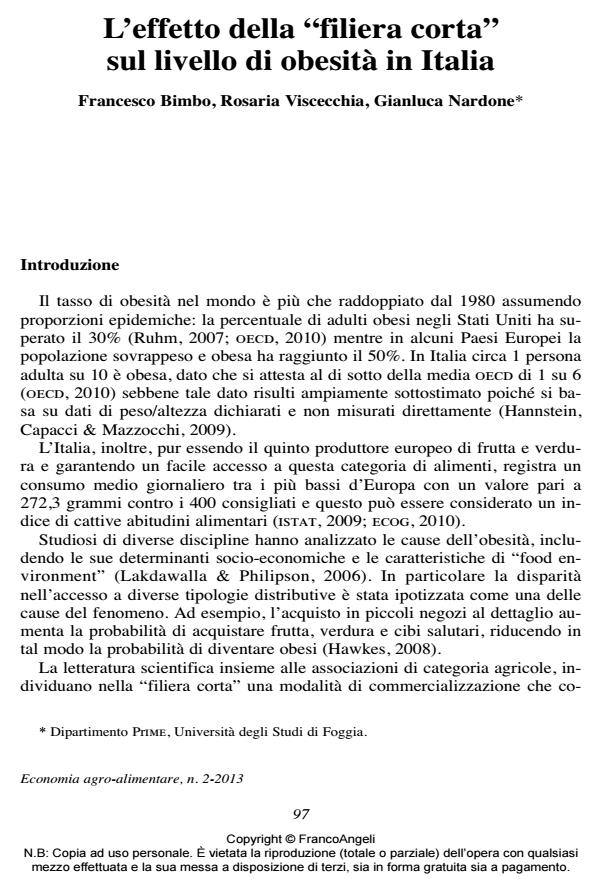Local food effect on Italian obesity level
Journal title ECONOMIA AGRO-ALIMENTARE
Author/s Francesco Bimbo, Rosaria Viscecchia, Gianluca Nardone
Publishing Year 2013 Issue 2013/2
Language Italian Pages 14 P. 97-110 File size 113 KB
DOI 10.3280/ECAG2013-002006
DOI is like a bar code for intellectual property: to have more infomation
click here
Below, you can see the article first page
If you want to buy this article in PDF format, you can do it, following the instructions to buy download credits

FrancoAngeli is member of Publishers International Linking Association, Inc (PILA), a not-for-profit association which run the CrossRef service enabling links to and from online scholarly content.
Obesity rate worldwide have more than doubled since the 1980s, reachingunprecedented level, it has exceeded 30% in the U.S. while in some EuropeanCountries the population being overweight and obese has reached 50% (oecd, 2010).In Italy about 1 over 10 adults are obese, below the oecd average of 1 over 6, butthese data come from-self reported individuals weight and height and could alreadybe severely underestimated (Hansstein et al., 2009; oecd, 2010). Lastly, Italy is thethird largest spender among the eu-15 in terms of direct health-care and indirect costdue to the obesity, around its € 4.7 billion (Fry and Finley, 2005).Our study aims to evaluate the impact of local food retail systems such asfarmers’ market and farmers who sell directly from farm, on adult obesity level inItaly since preliminary evidence demonstrated that buying local food in farmers’markets has positive influence both on food habits both on health (Pascucci S. et al.,2011).We use a cross-section of individual-level data on bmi and others individualcharacteristics, from the Multipurpose Survey of Households: Aspect of Daily Lifeof the Italian National Institute of Statistics (istat), year 2009, matched withregional-level data on food outlets density such as farmers’ market, and farmers whosell directly from farm (Fondazione campagna amica - Coldiretti, OsservatorioNazionale del Commercio, 2009). Food store location endogeneity was accounted foradopting an IV estimation method exploiting variation in supply-side factorsimpacting the location decision of different food retailers.The study shows the evidence that the having access to local food is associated toa reduction in obesity rate. In particular, we found that the having access to farmers’market and farmers who sell directly from farm reduce the bmi of "0.55 and "0.12respectively. These evidences confirm the importance to promote "direct saleformat" in order to improve not only farmers’ profitability but also consumers’ wellbeingwith consequent reduction of obesity health-care costs.
Keywords: Obesity, food access, farmers’ market
Jel codes: I18, Q18
Francesco Bimbo, Rosaria Viscecchia, Gianluca Nardone, L’effetto della "filiera corta" sul livello di obesità in Italia in "ECONOMIA AGRO-ALIMENTARE" 2/2013, pp 97-110, DOI: 10.3280/ECAG2013-002006